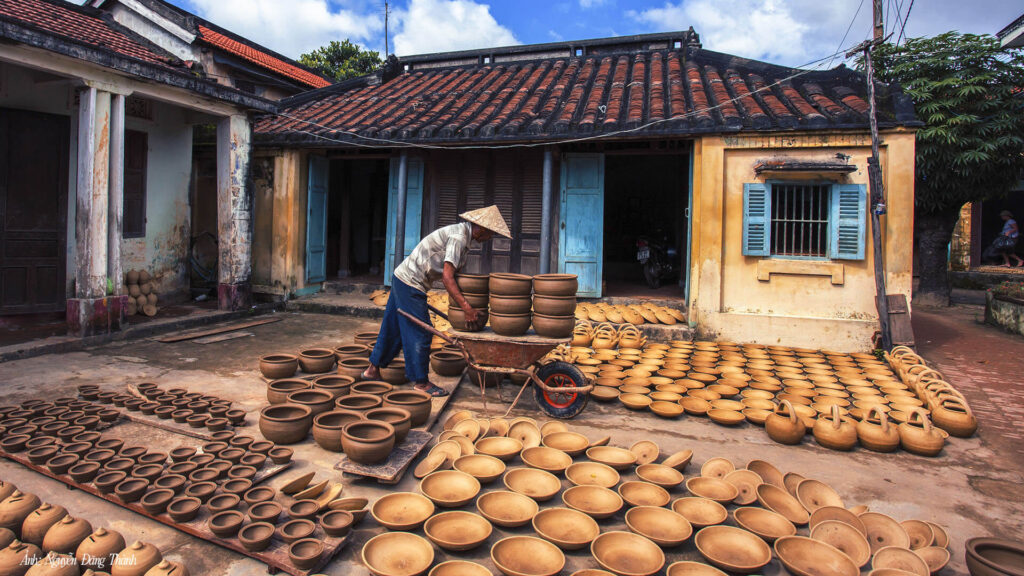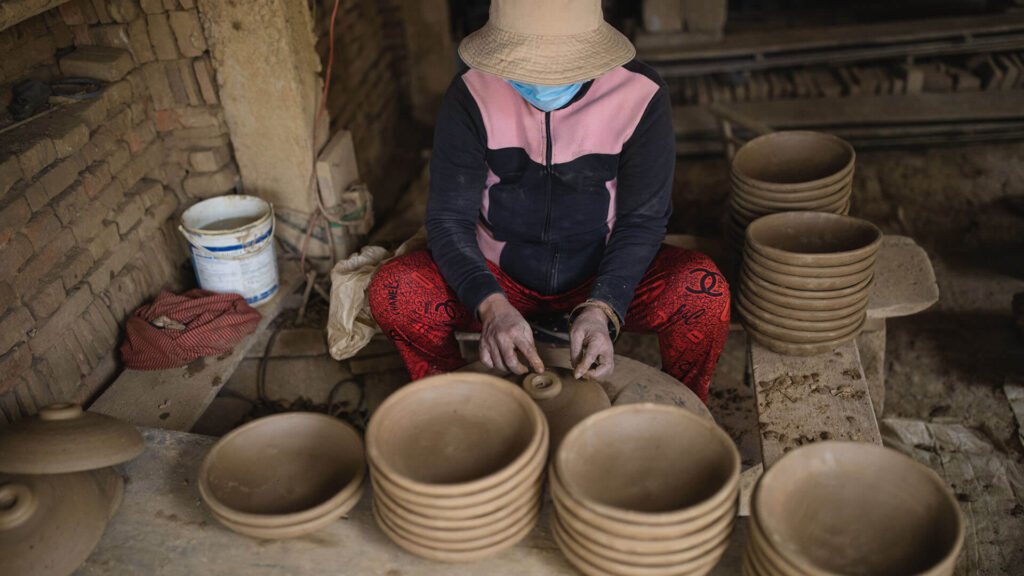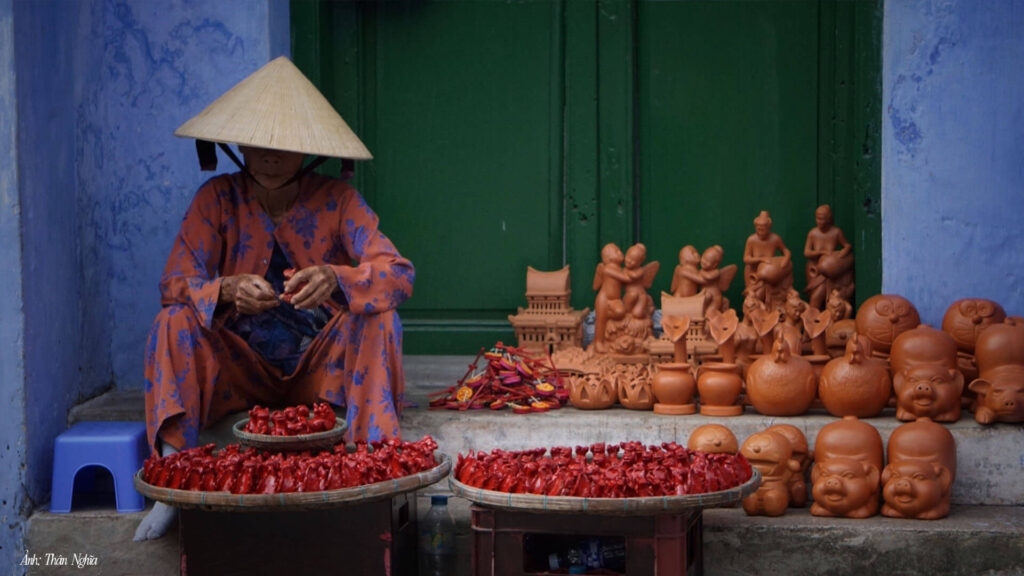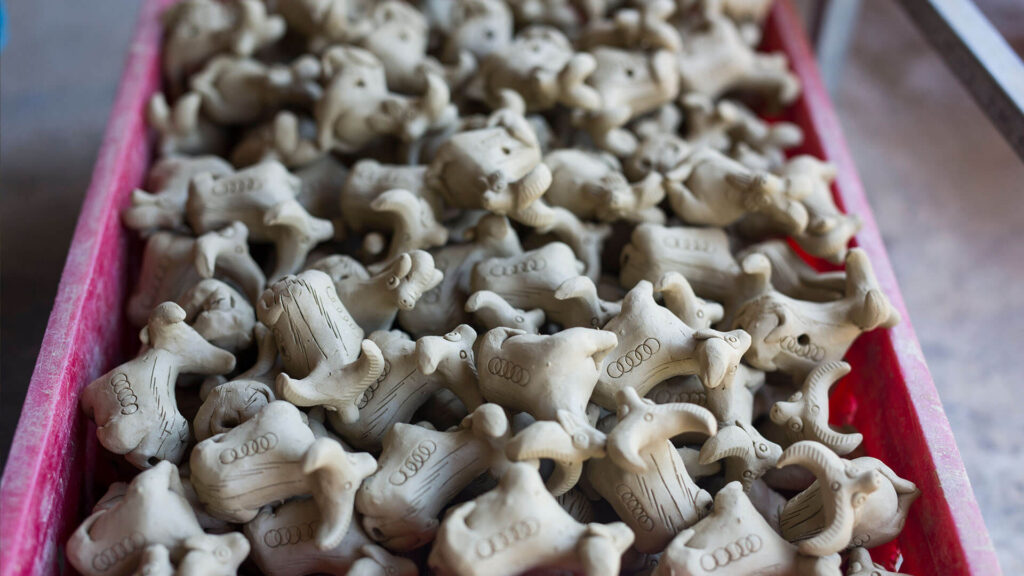Thanh Ha Pottery Village is now part of Hoi An Tay Ward, Da Nang City (before 1945, it belonged to Thanh Ha Commune, Dien Phuoc District, Dien Ban Prefecture, Quang Nam Province).
GENERAL INTRODUCTION TO THANH HA POTTERY VILLAGE
Thanh Ha Pottery Village is now part of Hoi An Tay Ward, Da Nang City (before 1945, it belonged to Thanh Ha Commune, Dien Phuoc District, Dien Ban Prefecture, Quang Nam Province). The village’s production spaces for pottery, stoneware, bricks, yin-yang roof tiles, and lime were distributed across several hamlets in the western and southern areas of the village, such as Nam Dieu, Thanh Chiem, An Bang, Hoa Yen, and Hau Xa. The main pottery production area is concentrated in Nam Dieu Quarter, Thanh Ha Ward, Hoi An City.

HISTORY OF FORMATION AND DEVELOPMENT
- SCALE AND HISTORY OF DEVELOPMENT
According to the recollections of village elders, about 70 years ago, Nam Dieu Hamlet had as many as 50 pottery-producing households, 30–40 potter’s wheels, 8 stoneware kilns, and dozens of pottery-trading households, employing a total workforce of 200–300 people. In addition, there were also several households engaged in the production of pottery, stoneware, bricks, tiles, and lime in Thanh Chiem Hamlet (now Thanh Chiem Quarter, northeast of Nam Dieu), An Bang Hamlet (now An Bang Quarter, north of Nam Dieu), and Hau Xa Hamlet (about 1 km east of Nam Dieu).
CULTURAL SPACE AND PRODUCTION CONDITIONS
- Current Situation of the Pottery Craft
Currently, the people of Thanh Ha maintain 32 pottery-making households with 134 workers out of a total of 320 households. Among them, 5 households produce traditional pottery, 13 households specialize in making clay whistles, while the rest focus on crafting decorative pottery; in addition, there are at least 3 professional pottery traders. The village has 4 traditional kilns (inverted and dome-shaped kilns), 4 upright kilns for firing decorative pottery, and 5 upright kilns for firing clay whistles.
Today’s team of potters in Thanh Ha are all descendants of the founding clans of the village: Nguyen Viet, Nguyen Van, Nguy, Bui, Pham, and Le.
- Materials for Pottery Making
The main material for pottery making is yellow clay, which is plastic and highly adhesive. This type of clay is usually found in riverbank fields at a depth of about 50–100 cm below the surface. About 60 years ago, clay was sourced from An Bang and Thanh Chiem Hamlets (Thanh Ha), as well as from areas adjacent to Thanh Ha that today belong to Dien Phuong. At present, potters purchase clay from Thanh Quyt (Dien Ban), Thi Lai (Duy Xuyen), and other areas, with clay sellers transporting it by boat to Thanh Ha for sale.
PRODUCTION / HARVESTING PROCESS

Traditional pottery products are crafted according to the following ancestral production processes:
- Stages of Crafting:
Clay preparation: The clay is mixed with water and then worked using tools such as the mai dỡ, mai tỉa, mai chém, and ne to chop and cut it into lumps, kneading it three times until it becomes clean and pliable.
Pottery shaping (forming the clay body): One craftsman pushes the potter’s wheel while another sits beside it, placing the clay lump onto the wheel. Using both hands, the potter presses and molds the clay into the desired form.
Finishing: The clay body is sun-dried gradually until semi-dry, then trimmed and adjusted for balance before being fully dried to harden completely.
Glazing technique (used for thanh lưu ly and hoàng lưu ly tiles): The glaze is made from copper, lead, hematite, kaolin, and other materials. These ingredients are finely ground, mixed with 50% clean water to create raw glaze, which essentially forms a thin glassy layer to polish and waterproof the pottery surface. The pottery, after being lightly fired, is taken out, dipped into the glaze, and then refired so that the glaze matures and adheres firmly to the pottery surface.
Firing pottery: Pottery and stoneware are fired in dome kilns (lo bau). The stoneware kiln, called the “green kiln” (lo xanh), and the pottery kiln, called the “red kiln” (lo do), differ in size and structure. The green kiln is rectangular, with brick walls and a domed clay roof; it measures about 3m high, 5–6m wide, and 4–5m long, with two fire doors at the front (for stoking wood), three air vents at the back, and three vents on the roof. The red kiln is smaller, about 2.3m high, 2m wide, and 3m long.
Traditionally, firewood used for firing included woods such as den, de, truong, and tram. Today, kiln workers mainly use casuarina (phi lao) wood. Each firing of stoneware requires about 10 m³ of wood, while pottery firing takes 5–7 m³.
The firing process consists of un (preheating the kiln) and chum that (intensifying the fire to finish the products). By experience, kiln workers can tell when the pottery is finished by observing when clear smoke escapes from the chimney, which indicates the proper temperature has been reached. In earlier times, potters also used om tham (test pieces) placed at the air vents to monitor the firing process. When the test piece, exposed to the heat, matured, it signaled that the products inside the kiln were ready. Based on the condition and color of the om tham, potters could further judge whether the batch had been successfully fired or not. The craft even developed a specialized vocabulary to describe these test-piece states, reflecting the accumulated knowledge of the trade.
TYPICAL PRODUCTS

Traditional pottery products are crafted according to the following ancestral production processes:
- Traditional Thanh Ha pottery and stoneware: highly diverse in forms (over 40 types of products), including household wares (jars, lime pots, vats, cooking pots, large jars, braziers, water containers, om pots, bung/lung binh containers, etc.) used to store water, salt, fish sauce, rice, grains, and local produce; tools for the weaving craft in Duy Xuyen and Dien Ban, and for sugar-making in Dai Loc – Quang Nam (now Da Nang) (such as cocooning vats, thread-holding bowls, and sugar-filtering ladles); baked clay bricks and roof tiles; and ceramic items used in spiritual practices (incense burners, Kitchen God figurines, burial jars, etc.).
The distinctive forms of the products include jars with flared mouths, constricted necks, sloping shoulders, tapering bases, and flat bottoms; pots, pans, cauldrons, and kettles that share the same flared-mouth design, with rounded rims, short constricted necks, large swollen bodies, and rounded bottoms. Thanh Ha pottery and stoneware are unglazed, with smooth or coarse surfaces and fine clay bodies, mostly undecorated, except for certain types of stoneware jars that are adorned with raised serrated bands or wave patterns around the neck and shoulders.
- Decorative pottery: crafted with greater refinement. To achieve a smooth ceramic surface, potters beat, settle, and filter the clay into a fine slurry, which is then poured into molds for 12 hours until the clay settles, after which the clay bodies are dried. Decorative motifs on these products often include Chinese characters symbolizing good fortune, geometric patterns, or the names of business establishments. Some items are even given a ceramic coating made from eggshells. The clay bodies for decorative pottery can be fired either in dome kilns or separately in upright kilns.
Decorative pottery includes at least 33 types of products, such as statues of the Buddha and Christian figures, ceramic wall lamps, balusters, pots, vases, architectural monument models, boxes, ashtrays, and ceramic masks.
These products are ordered by many tourism and service establishments (restaurants, hotels, cafés) in Hoi An, Da Nang, Hue, Da Lat, and Ho Chi Minh City for interior and exterior decoration. In recent years, some items have also been exported to Japan, Australia, Germany, the United Kingdom, France, the United States, and other countries.

- Clay whistles – souvenir products: Clay whistles are a newer form of pottery that emerged in the late 1990s. Although simply crafted, these items often feature traditional cultural themes such as the 12 zodiac animals or figures like the buffalo-herding child, making them popular souvenirs among tourists.
- Making yin-yang roof tiles: Yin-yang tiles are made from the same yellow clay used for pottery and go through several stages: kneading the clay, molding the clay bodies, sun-drying for one day, shaping (stacking in rows and beating them into curved tile forms), arranging in separate rows (vo ne), sun-drying for another day, and then firing in the kiln. The tiles are fired either in dome kilns (used for stoneware and pottery) or upright kilns (used for bricks and tiles) and are produced in various sizes.
- Making bricks: The process is similar to that of making yin-yang roof tiles, except that molds are used and the shaping (rap) stage is omitted.
- Making Kitchen God statues: Preparing refined clay, kneading the clay, hand-molding, sun-drying for two days, and then firing.
- Ceramic coffins are also a spiritual product (used for reburial of the deceased), crafted through the following steps: preparing refined clay, kneading the clay, hand-molding piece by piece, assembling, sun-drying, and firing.
Thanh Ha Pottery Village was recognized as a provincial-level traditional craft village in 2014. By 2019, The Craft of Thanh Ha Pottery in Hoi An was inscribed on the National Intangible Cultural Heritage List by the Ministry of Culture, Sports and Tourism under Decision No. 2695/QĐ-BVHTTDL, dated August 27.
DA NANG CITY TOURISM PROMOTION CENTER